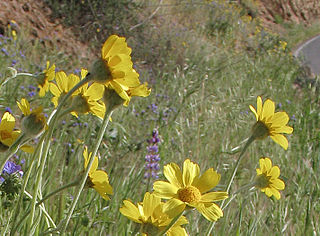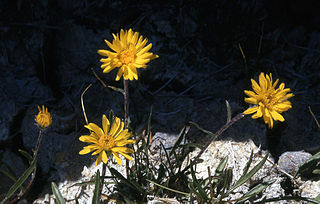
Microseris nutans is a species of flowering plant in the family Asteraceae known by the common name nodding microseris. It is native to western North America, including southwestern Canada and much of the western United States, including the Sierra Nevada in California, where it grows in many types of habitat.

Pyrrocoma is a genus of North American plants in the family Asteraceae. These wildflowers are sometimes known as goldenweeds.

Grindelia nana is a species of flowering plant in the daisy family known by the common names Idaho gumplant and Idaho gumweed. It is native to western North America, especially the western United States, where it can be found in a number of dry habitats. This is a weedlike perennial herb growing mainly erect to heights between 20 centimeters and one meter. Its stems and foliage are mostly green with some reddish coloration. Leaves are up to 9 centimeters long. The tops of the stem branches bear flower heads one or two centimeters wide, which are bell-shaped with rounded bases. The head is a cup of green clawlike, curling or erect phyllaries.

Hazardia squarrosa is a North American species of shrub in the family Asteraceae known by the common name sawtooth goldenbush. It is native to California in the United States and Baja California in Mexico.
Hulsea californica is a rare species of flowering plant in the family Asteraceae known by the common names San Diego alpinegold and San Diego sunflower. It is endemic to southern California, where it grows only in the Peninsular Ranges.

Solidago nemoralis is a species of flowering plant in the family Asteraceae. It is native to North America, where it is widely found in Canada and the United States. Its common names include gray goldenrod, gray-stem goldenrod, old-field goldenrod, field goldenrod, prairie goldenrod, dwarf goldenrod, and dyersweed goldenrod.
Lessingia tenuis is a species of flowering plant in the family Asteraceae known by the common name spring lessingia. It is endemic to California, where it is known from the San Francisco Bay Area to Ventura County. It grows on the slopes of the California Coast Ranges in common local habitat such as chaparral.

Monolopia lanceolata, the hillside daisy or common monolopia, is a species of flowering plant in the family Asteraceae. It is endemic to the southern half of California, where it grows in many types of habitat, including coastal and valley grassland, chaparral, woodland, and desert.

Monolopia major is a species of flowering plant in the family Asteraceae known by the common name cupped monolopia.

Pyrrocoma apargioides is a species of flowering plant in the family Asteraceae known by the common name alpineflames. It is native to the western United States from the Sierra Nevada of California east to Utah, where it grows in the forests and meadows of high mountains. It is a perennial herb growing from a taproot and producing one or more stems to 30 centimeters in length. The stems are decumbent or upright, reddish, and hairless to slightly woolly. Most of the leaves are located around the base. They are thick and leathery, lance-shaped with large sawteeth along the edges, often center-striped in white, and measure up to 10 centimeters long. The inflorescence is usually a single flower head lined with centimeter-long phyllaries which are reddish to green with red edges. The head has a center of yellow disc florets and a fringe of ray florets which are yellow, often splashed with red along the undersides, measuring up to 1.6 centimeters in length. The fruit is an achene which may be well over a centimeter in length including its pappus.

Pyrrocoma carthamoides is a species of flowering plant in the family Asteraceae known by the common name largeflower goldenweed. It is native to western North America from British Columbia to northeastern California to Wyoming, where it is known from grassland, woodlands, forests, barren areas, and other habitat. It is a perennial herb growing from a taproot and producing one or more stems to about half a meter in maximum length, the stems reddish-green and leafy. The largest leaves are at the base of the stem, measuring up to 20 centimeters long, lance-shaped with spiny sawtoothed edges. Leaves higher on the stem are smaller and hairier. The inflorescence is a single flower head or a cluster of up to four. Each bell-shaped head is lined with phyllaries each up to 2 centimeters long. It has many yellow disc florets surrounded by a fringe of yellow ray florets up to 7 millimeters long; ray florets are occasionally absent. The fruit is an achene which may be well over a centimeter in length including its pappus.

Pyrrocoma lucida is a species of flowering plant in the family Asteraceae known by the common names sticky goldenweed and sticky pyrrocoma. It is endemic to California, where it is known only from the northern Sierra Nevada. It grows in mountain forests and clay flats with alkali soils. This is a perennial herb growing from a taproot, producing an erect stem up to 75 centimetres (30 in) tall. It is hairless and glandular, its surface resinous and shiny. The leaves are lance-shaped with sharply toothed edges, the largest near the base of the stem reaching 25 centimetres (10 in) in length. Smaller leaves up to 10 centimetres (4 in) long occur higher on the stem. The inflorescence is a narrow spikelike array of many flower heads lined with thick, overlapping, gland-dotted phyllaries. Each head contains up to 40 yellow disc florets surrounded by a fringe of up to 20 yellow ray florets. The fruit is an achene up to a centimeter long including its pappus.

Pyrrocoma racemosa is a species of flowering plant in the family Asteraceae known by the common name clustered goldenweed. It is native to the western United States, where it grows in many types of habitat. It is quite variable in morphology, and there are several varieties which are sometimes hard to tell apart. In general, it is a perennial herb usually producing two or more mostly erect stems reaching maximum heights between 15 and 90 centimeters. The stems are reddish or brownish in color, leafy or not, and hairless to quite woolly. The longest leaves are located in tufts around the base of the stems. They are lance-shaped to oval, smooth-edged, wavy, or deeply spine-toothed, and may exceed 30 centimeters in length. Basal leaves are borne on woolly petioles. Leaves located higher on the stem lack petioles and may clasp the stem at their bases. The inflorescence is a cluster of several flower heads lined with phyllaries which may be over a centimeter long and are hairy to hairless in texture. Each head contains many yellow disc florets and a fringe of several yellow ray florets. The fruit is an achene which may be over a centimeter long including its pappus.

Pyrrocoma uniflora is a species of flowering plant in the family Asteraceae known by the common name plantain goldenweed. It is native to western North America from central Canada to California to Colorado, where it grows in several types of habitat, including forest and meadows with alkali soils, such as those near hot springs. It is a perennial herb growing up to 40 centimeters tall, the stems reddish and usually with a thin to thick coating of woolly fibers. The lance-shaped, toothed leaves are usually woolly, the largest near the base of the plant reaching up to 12 centimeters in length. The inflorescence is a single flower head or a cluster of a few heads, each lined with woolly phyllaries. The head contains yellow disc and ray florets. The fruit is an achene which may be over a centimeter long including its long pappus.

Raillardella pringlei is an uncommon species of flowering plant in the family Asteraceae known by the common name showy raillardella.
Packera subnuda is a species of flowering plant in the aster family known by the common names Buek's groundsel and cleftleaf groundsel. It is native to western North America from the Northwest Territories to northern California to Wyoming, where it grows in high mountain meadows in subalpine and alpine climates.
Packera pauciflora is a species of flowering plant in the aster family known by the common name alpine groundsel. It is native to northern North America, where it can be found in parts of western and eastern Canada and the northwestern United States. It grows in subalpine and alpine climates, such as mountain meadows.

Pyrrocoma clementis is a species of flowering plant in the family Asteraceae known by the common name tranquil goldenweed. It is native to Colorado, Utah, and Wyoming in the United States.

Arnica lanceolata is a North American species of flowering plant in the family Asteraceae, known by the common name clasping arnica or lanceleaf arnica. It has a disjunct (discontinuous) distribution in western North America and northeastern North America.

Pyrrocoma liatriformis is a species of flowering plant in the family Asteraceae. Its common names include Palouse goldenweed and smallhead goldenweed. It is native to the northwestern United States, where it is endemic to the Palouse prairie, growing in grassland dominated by blue bunchgrass. It is a perennial herb growing from a taproot, producing one to three stems up to 70 centimeters in length. The stems are erect and hairy. Leaves near the base of the plant are larger and rounder than the leaves connected to the stem, which are lanceolate and hairy. Basal leaves measure 80–310 millimeters long and 9–30 millimeters wide, whereas cauline leaves measure 30–120 millimeters long and 5–20 millimeters wide. The inflorescence is four to five heads arranged in a raceme. Each head is composed of 17–25 yellow ray florets, each 6–14.5 millimeters in length, as well as 35–60 disc florets, each 7–11 millimeters in length.

















